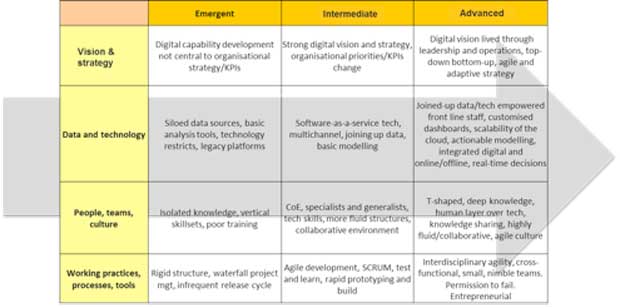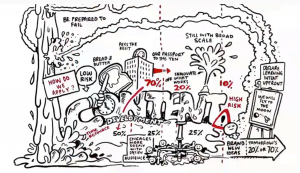
How do you create a marketing function within your organization that is world class? There are some interesting clues in a brilliant article by eConsultancy’s Ashley Friedlein. I want to concentrate on the last row of their marketing capability maturity model, shown above. The model has three columns: emergent, intermediate and advanced.
- Emergent – Rigid structure, waterfall project management, infrequent release cycle
- Intermediate – Agile development, SCRUM, test and learn, rapid prototyping and build
- Advanced – interdisciplinary agility, cross-functional, small, nimble teams. Permission to fail. Entrepreneurial
I currently run private training classes and soon will offer public training classes that can help a team move from emergent to intermediate. It is fairly straightforward, although a lot of work, to learn and adopt agile development techniques, SCRUM, prototyping and a test and learn mentality. However, as Ashley rightly points out, the best marketing teams don’t stop there. Let’s take a look at some of the factors that differentiate the advanced teams from the intermediate.
Interdisciplinary Agility
What does Ashley mean by interdisciplinary agility? He provides a clue in the box above, where he suggests that advanced marketing teams need to hire and develop “t-shaped” people. The term t-shaped was coined by David Guest in 1991, but awareness of the term is mostly the result of efforts by Tim Brown, the CEO of the IDEO design firm. T-shaped people have both great depth in a particular area – perhaps analytics, product management, digital advertising, mobile or marketeering, and breadth, in that they collaborate well with people from other disciplines, and in fact are so interested in other disciplines that they tend to have great understanding and empathy for areas other than their own speciality.
Other people, including Ashley Friedlein and Scott Brinker, argue that we need to hire pi-people. That’s pi like the Greek letter pi, with broad horizontal skills, but also depth in both left brain skills (analytics, data, experimentation) and right brain skills (creativity, story telling, creating compelling customer experiences).
The key observation here is that it’s not enough to be a specialist in a particular area of marketing. To be successful on a world class marketing team, you must also be able to effectively collaborate with other experts, of both the left brain and right brain persuasion, and know enough about their fields to be able to make effective use of their expertise.
Ashley also suggests that world class marketing organizations will be composed of small teams. What should we consider small? How many people on the ideal team? And what’s the composition of that team?
In agile software development, there is some evidence that although Scrum can scale up to teams of any size, including teams of hundreds of people, the most productive teams are smaller, around 7 people, plus or minus 2. I think that’s about right for marketing teams. So 5 to 9 people on a team is probably most productive. Above that, multiple teams can work on separate projects, ideally ones that don’t require coordination. In terms of the composition of the team, I haven’t seen any research on this, but I have an opinion. I think each team needs at least one person who is strong in each of the following areas:
- Product management – this is a traditional marketing skill, but still one that is very important. This person often serves as the product owner on a Scrum team. They have great depth in the usual product manager skills – customer relationships, strategic business skills, requirements gathering, positioning, sales enablement, revenue management. But they also must be able to collaborate with everyone else on the team.
- Analytics – I recently read an article about Dan Wagner, the Chief Analytics Officer for the Obama campaign. Every marketing team needs a guy like Dan.
- Design & User Interface – if you’re going to create remarkable customer experiences, something I think is at the foundation of Agile Marketing, you need someone who deeply understands design and user interface principles.
- Marketeer/Growth Hacker – I prefer the term marketeer to growth hacker, but you need someone on the team who can write code and build stuff. A marketing engineer, in other words, or marketeer.
- Scrum Master – You need someone who keeps the rest of the team on track, eliminates obstacles and generally manages the process.
For particular projects, you may want depth in other skills – digital advertising, social media, PR, channel marketing – but many of these are generalist skills that almost everyone should have (social media) or they can be outsourced (digital advertising).
Permission to Fail
I would use an even stronger term than permission to fail: planning to fail. VC’s take a portfolio approach, planning on the almost certainty that some of their investments will fail. Paul Graham has a very interesting perspective in his article Black Swan Farming. In particular, his description of a Venn diagram with two circles, one labeled “seems like a bad idea” and the other “is a good idea”, where the best startups are found at the intersection of those two circles. In other words, you have to deliberately support things that at first sound like a bad idea. When you do that, you’re sure to put energy behind lots of failures that don’t turn out to be “a good idea”. We need to do the same thing in marketing. I’m sure at least one person thought that the AFLAC duck or the Allstate mayhem guy were bad ideas, but they worked for these brands.
Entrepreneurial
Lastly, Ashley Friedlein argues that marketers on the advanced teams are “entrepreneurial”. Sounds good, but what does that really mean? Eric Ries, in The Lean Startup, defines a startup as “a human institution designed to create a new product or service under conditions of extreme uncertainty,” and he defines an entrepreneur as someone who provide the vision and the management to lead teams through those “conditions of extreme uncertainty”. There are lots of good marketers who can lead teams through gradual improvement of existing businesses, where there is a roadmap. But it takes someone special to lead a team through something that’s never been done before, through conditions of extreme uncertainty. How do we find and train that next generation of entrepreneurial marketers? That’s a question (and maybe an answer) for a future blog.
What do you think? If you’ve been witness to a world class marketing team, what characteristics did they possess? How did the team form?




Hello Jim, I found the “Permission to Fail” section inspiring. From experience, I find that we hesitate to talk about failure with leaders when we form teams. The reality is that failure is inevitable, but also vital to success. May organizations that I work with have a fear-based culture pitted against failure, often based on institutional experience where employees who “failed” had a negative experience.
On my first Agile engagement, I worked with a CEO who understood the Lean Startup, the possibilities excited him. Instead of saying “fail fast”, he used to say “learn fast”.
I believe the work we need to do with leadership is so important. Many of the principles, values, and practices that we want to infuse with Teams, we need to infuse with leaders too. When they understand that failure is not to be feared because they lead the charge, the Teams have the right environment to experiment, test, and learn.